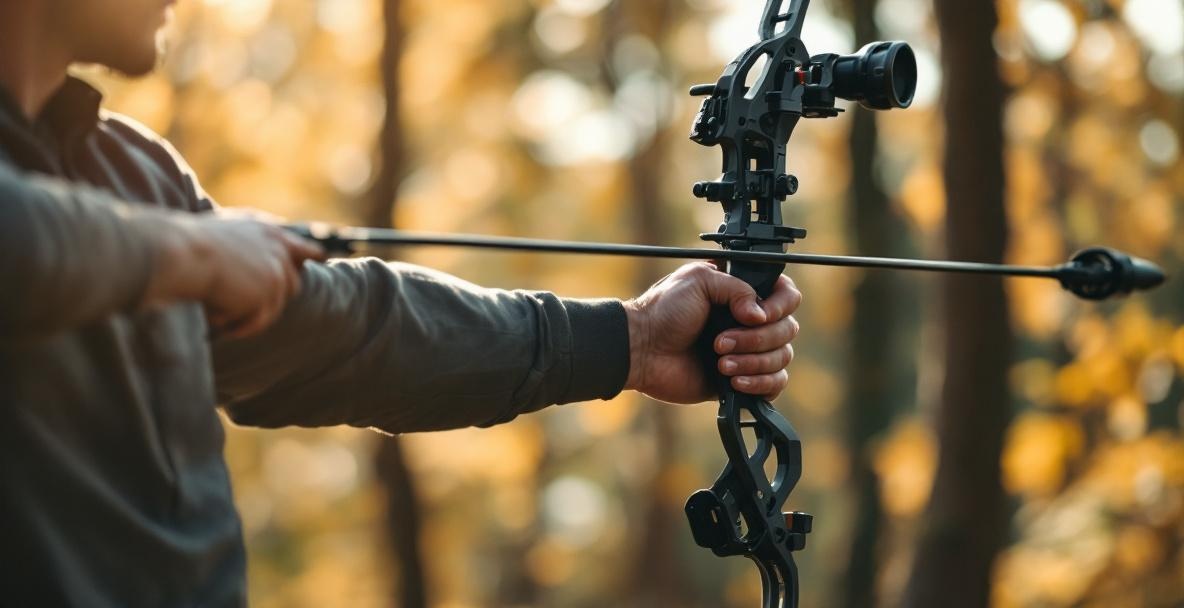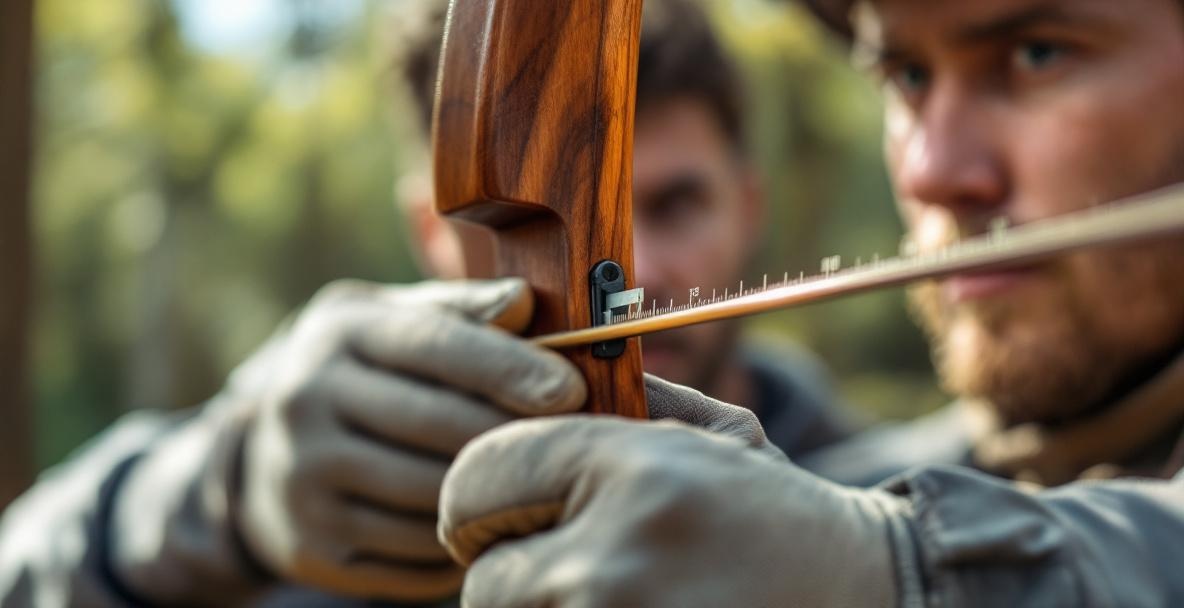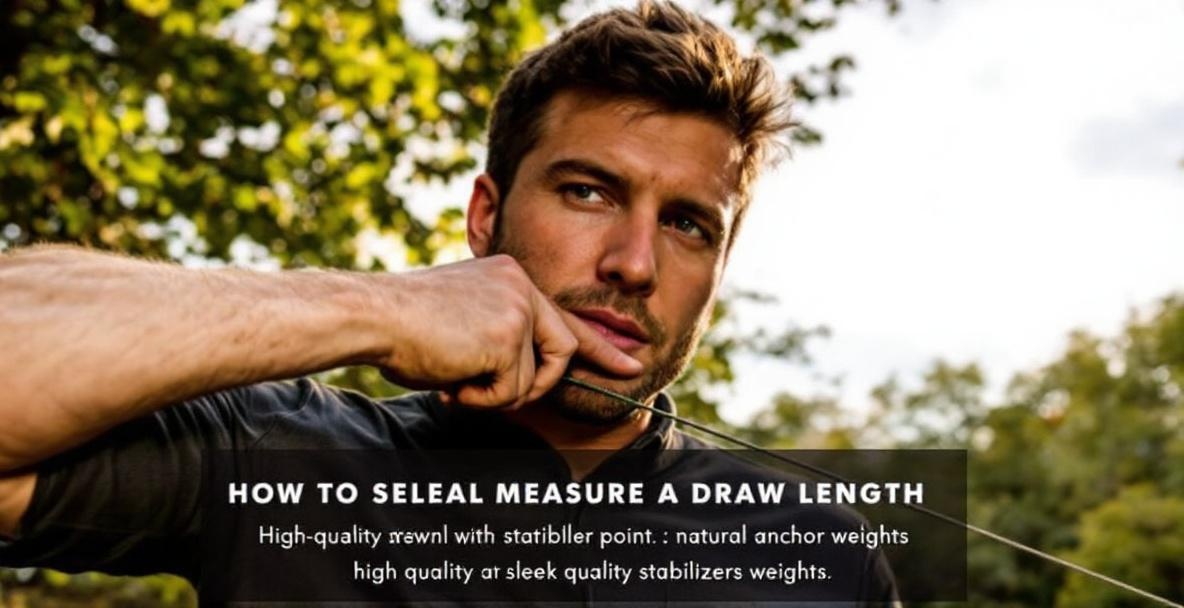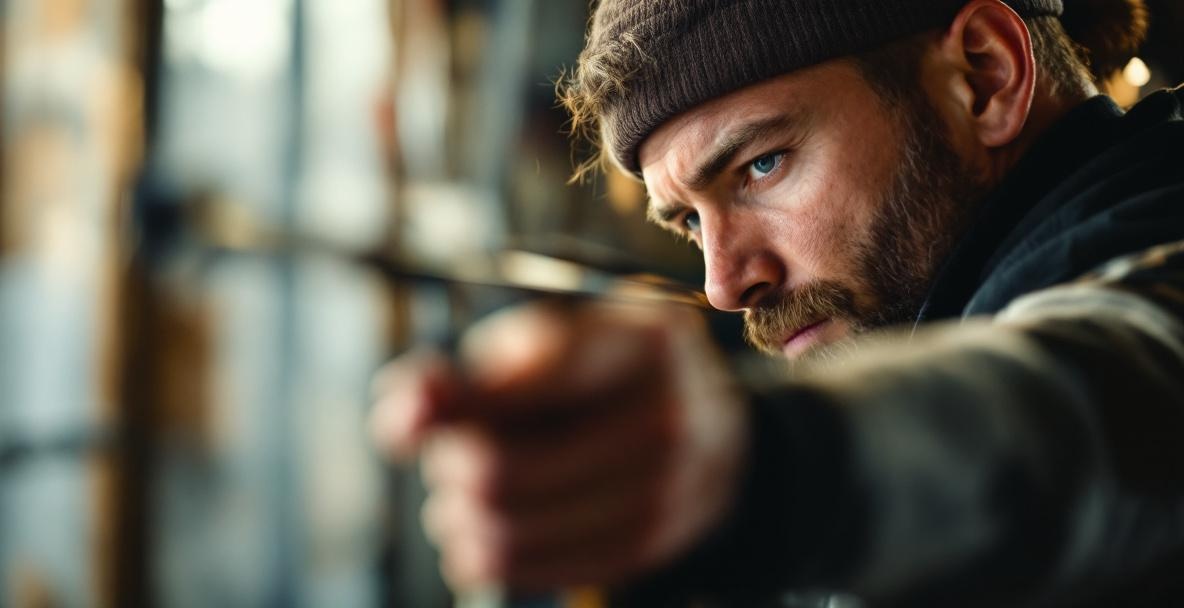Start Your Journey with the Right Draw Length

When you’re out on the range, every shot counts, and your draw length can make all the difference. Whether you’re new to archery or have been shooting for years, knowing your exact draw length helps you hit targets more consistently while keeping your form in check. A proper draw length eases fatigue and makes shooting much more comfortable. Think of it as the solid foundation for your entire setup-from where you position your stabilizer weights to your overall stance.
“Draw length transforms an archer's experience – it improves accuracy, reduces fatigue, and boosts overall shooting comfort.”
Why the Right Draw Length Is a Game-Changer
Your draw length isn’t merely a number. It’s a vital part of your shooting setup that helps you find a natural anchor and smooth release. When your draw perfectly fits your body, your form aligns effortlessly, and you gain a consistent shot each time. If it’s off even by a bit, your shot pattern can suffer, affecting your overall performance over time.
When the draw is too long, you stretch beyond comfort, which can lead to shoulder strain and a shaky anchor. Many archers end up with arrows that fly too high or too low because they’re overextending. On the other hand, if it’s too short, you feel cramped, which limits the power behind your shot and messes up your back tension. The end result is a less efficient use of your draw muscles and a drop in accuracy.
| Aspect | Too Short | Proper | Too Long |
|---|---|---|---|
| Body Alignment | Cramped shoulders and compressed posture | Natural, balanced spine alignment | Overextended arms and strained shoulders |
| Anchor Consistency | Hard to reach repeatable point | Solid, repeatable anchor | Anchor drifts past reference point |
| Power Transfer | Limited arrow speed | Efficient energy transfer | Energy wasted through over-extension |
| Injury Risk | Elbow & neck tension | Minimal when form is correct | High shoulder & back strain |
| Typical Impact Pattern | Low left/right misses | Tight groupings | High/low “spray” pattern |
Nailing Down Your Baseline Measurement
Before you dive into measurement tricks, it’s good to understand what you’re really checking. Your ideal draw length is as unique as you are, largely based on your arm span relative to your height. There isn’t a one-size-fits-all answer here. Most archers find their number lands somewhere between 26-30 inches, but if you are younger or have a smaller frame, your draw might be shorter, while taller archers could need over 30 inches. The goal is to work with your own body.
When your draw length fits right, you can keep your form natural. Your bow arm stays slightly bent, your shoulders relax, and your release hand finds that perfect anchor spot near your face or jaw. This balanced stance is the key to steady, consistent shooting every time you notch an arrow.
“When properly fitted, your draw length should allow you to maintain proper form with your bow arm slightly bent, shoulders relaxed and level, and your release hand positioned at a comfortable anchor point.”
Grasping Your Draw Length: What It Is and Why It Counts

At OneX Archery, we know that getting your draw length right is critical. It lays the groundwork for everything you do on the range, from your shot accuracy to your overall comfort. Before you fine-tune your gear with our precision stabilizer weights, make sure your draw length matches your body perfectly. Let’s break down what it really means so you can see why it matters so much.
What Draw Length Is All About
Simply put, your draw length is the distance from the bowstring at full draw to the pivot point on the grip, plus an extra 1.75 inches per standard practice. Imagine it like the fit of a tailored suit – if it matches your body, everything feels natural. Getting this right means your whole body, from your fingers to your shoulders, works in harmony with each pull.
For those using compound bows, the draw length is usually set and locked by the cam system. Recurve archers, however, can adjust it slightly shot to shot. Either way, your draw length becomes your archery fingerprint – unique and fundamental to nailing a steady shot.
Why Getting Your Draw Length Right Matters
Using a bow with a mismatched draw length is like running in shoes that are too tight or too loose. If your draw extends too far, you overdo it, causing tension in your shoulders and back, and your arrow groups start to scatter. If it’s too short, you feel squeezed, and your back muscles can’t engage fully, robbing you of power and consistency. It’s not just about hitting the target – it’s also about feeling comfortable as you draw.
Beyond accuracy, the right draw length boosts your comfort and helps you practice longer without pain. When everything fits just right, you focus on your shot instead of battling your gear. At OneX Archery, we see that a proper draw length is key, especially when pairing it with our precision stabilizer systems to get the best performance.
How to Measure Your Draw Length at Home

You don’t have to visit a pro every time you want to check your draw length. Learning to measure it yourself builds confidence in your gear and sharpens your aim. In this part, we’ll show you a few solid ways to find your draw length at home. With the right tools, you can get accurate numbers that help you select the right bow for your body type.
Simple Ways to Measure Your Draw Length
A popular starting method is the wingspan technique. Stand straight with your arms out like you’re making a T. Ask a friend to measure from the tip of one middle finger to the other. Once you have that number in inches, divide it by 2.5. This gives you a rough estimate of your draw length.
To refine your measurement further, try the arrow method. You will need a friend and an unstrung bow. Get into your natural shooting stance and mimic drawing your bow to your usual anchor point. Have your friend mark the spot where the arrow’s nock should be. Then, measure from that mark to the grip’s pivot and add 1.75 inches. This extra bit makes up for the distance between the grip pivot and the arrow rest.
If you’re measuring on your own, the wall method is a reliable alternative. Stand with your back flat against a wall and stretch your arms out until they touch it. Ask someone to mark where your middle fingers end. Measure the gap between those marks and divide by 2.5. This method gives you another solid starting point. Just remember to always stand naturally since small changes in your anchor can affect the result.
| Method | Best For | Accuracy | Tools Needed | Pros | Cons |
|---|---|---|---|---|---|
| Wingspan Formula | Quick self-assessment | Moderate (±½") | Tape measure | Fast and requires no extra gear | Doesn’t account for unique body proportions |
| Arrow Mark Method | Intermediate archers | High (±¼") | Helper, unstrung bow | Mimics real shooting motion | Needs a partner |
| Wall Method | Solo shooters | Moderate-High | Tape, wall | Easy to repeat | Requires enough wall space |
| Draw-Length Arrow | Advanced fine-tuning | Very High (±⅛") | Special arrow, helper | Extremely precise and visual measurement | Extra equipment purchase needed |
What You Need to Get the Job Done
You will definitely need a flexible measuring tape for this process. Unlike a hard ruler, a flexible tape follows your body’s curves, making it easier to measure your wingspan or reach to your anchor. Most household tape measures work well, yet a fabric variety often gives more consistent results.
For even more precision, consider getting a draw length arrow. This tool is marked along its shaft so you can see exactly where your draw ends while keeping your natural anchor. It isn’t essential for beginners, but when you refine your technique and aim for top performance, it proves very useful.
Getting a buddy to help makes the job much easier, but if you’re on your own, use a mirror or your smartphone. Record your shooting stance and then review the footage to see if every movement feels natural. This method works best when paired with the wingspan technique. Always remember that a perfect draw length is key to staying comfortable and maintaining a steady form, especially when using stabilizer weights.
Common Slip-Ups and How to Fix Them

Even seasoned archers can miss the mark when it comes to measuring draw length. At OneX Archery, we often see that an off measurement can wreck your shooting comfort and throw off the balance that makes our precision stabilizer weights shine. Spotting common mistakes early can make a huge difference in how you perform.
Spotting Common Mistakes
A frequent mistake is measuring your draw length while bundled up in thick or loose clothing. Extra layers can add unwanted inches, so you end up with a number that forces you into an awkward position. This makes it nearly impossible to enjoy the true balance our weights offer.
Another slip-up happens when you don’t stand naturally during the measurement. If you stretch too much or hunch your shoulders, you get a measurement that doesn’t match your real shooting form. The trick is to remain relaxed and in your usual stance. Some archers also rely solely on the wingspan formula without considering the unique shape of their arms or shoulders, which can lead to a setup that just doesn’t feel right.
| Common Mistake | How It Affects Draw Length | What It Looks Like | Simple Fix |
|---|---|---|---|
| Wearing Bulky Clothing | Adds 1-2" artificially | Overextended bow arm | Measure in fitted clothing |
| Poor Posture While Measuring | Inflates the wingspan | Inconsistent anchor point | Stand naturally and relax |
| Relying Solely on the Formula | Misses body-specific nuances | Scattered arrow groupings | Verify using at-bow measurement |
| Fatigue During Measurement | Shortens your wingspan | Dropping the elbow late | Measure when fresh and average over sessions |
Advice for Nailing the Perfect Measurement
A great tip is to get a friend to help you measure your draw length. A second pair of eyes can catch any mistakes in your stance or posture. This is especially useful for measuring your draw on the bow, as someone else can watch from different angles and offer instant feedback.
Try taking measurements on several different days instead of just one. Your natural stance might change a bit depending on the time of day or how tired you are. Averaging these readings gives you a reliable number that truly reflects your form. This extra care ensures that when you add your stabilizer weights, they work perfectly to reduce hand shock and improve your performance.
Feel free to tweak your draw length slightly once you have your baseline. Many archers find that a minor adjustment, even by a quarter inch, can make a big difference. As suggested by Archery GB on improving your game, start with your measured number and adjust slowly until you feel completely comfortable. Our stackable weight system lets you fine-tune your bow until it feels just right.
Keep in mind that as your drawing muscles strengthen, your ideal draw length might change a little. Recheck your measurements after intense training sessions or if something feels off. This ongoing attention to detail helps you enjoy the full benefits of our stabilizer weights.
Lock In Your Perfect Fit
Finding your perfect draw length is more than just a technical detail. It is the cornerstone of your archery setup and can truly transform your shooting experience. We’ve covered how to measure it, why it matters, and even how to dodge common pitfalls. Spending the time to get this right sets you up for success every time you draw.
When your draw length is on point, everything falls into place. Your stance becomes natural, your anchor points steady, and your release smooth. Over time, these improvements add up, turning frustration into satisfaction and making every shot count.
Level Up Your Archery Game
Once you’ve nailed your draw length, you can take your setup to the next level. The perfect fit works in harmony with every part of your gear, especially your stabilizer system. Our stabilizer weights offer a counterbalance that boosts accuracy while reducing fatigue, letting you shoot with confidence.
Remember that as you progress, your body might change too. Strengthening muscles and refining your technique can call for a fresh measurement from time to time. We always suggest incorporating specific archery exercises and resetting your setup each season or whenever something feels off.
Stay Consistent and Comfortable
Consistency is key in archery, and your draw length plays a major part in keeping things steady. Even small shifts can throw off your aim, so it pays to check your measurement regularly. This diligence helps ensure that your gear always fits just right as your skills evolve.
When your bow feels like a natural extension of your body, you can focus on your target instead of worrying about discomfort. A properly fitted draw reduces shoulder strain and lets your arm fall in place with ease, enabling longer sessions and more enjoyment of the sport.
Every archer’s journey is unique, and finding the right fit is a personal adventure. The methods above offer a reliable starting point, but don’t hesitate to seek advice from experienced archers or coaches if you need a second opinion. The archery community is supportive, and sharing tips can lead to insights you might not find anywhere else.
Ready to transform your archery experience with equipment that perfectly complements your draw length? Visit OneX Archery today to explore our range of precision-engineered stabilizer weights designed to work in harmony with your properly fitted bow, enhancing balance and stability for more accurate, consistent shots.
Leave a Reply